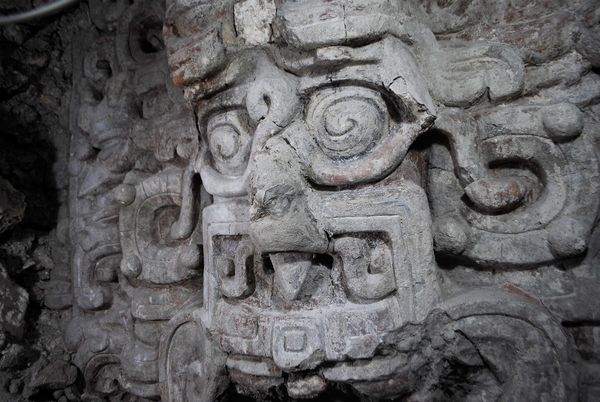
Excerpt from National Geographic.
In El Zotz some 1,600 years ago in what is now Guatemala, the Temple of the Night Sun was a blood-red beacon visible for miles and adorned with giant masks of the Maya sun god as a shark, blood drinker, and jaguar.
The sides of the temple are decorated with 5-foot-tall (1.5-meter-tall) stucco masks showing the face of the sun god changing as he traverses the sky over the course of a day. One mask is sharklike, likely a reference to the sun rising from the Caribbean in the east.
The noonday sun is depicted as an ancient being with crossed eyes who drank blood, and a final series of masks resemble the local jaguars, which awake from their jungle slumbers at dusk.
In Maya culture the sun is closely associated with new beginnings and the sun god with kingship. So the presence of solar visages on a temple next to a royal tomb may signify that the person buried inside was the founder of a dynasty—El Zotz’s first king.
They also found hints the Maya, who added new layers to the temple over generations, regarded the building as a living being. For example, the noses and mouths of the masks in older, deeper layers of the temple were systematically disfigured.
It is actually quite common in Maya culture. It’s very hard to find any Mayan depiction of the king that doesn’t have its eyes mutilated or its nose hacked … but ‘mutilation’ is not the appropriate term to describe it. It as more of a deactivation.
It’s as if they’re turning the masks off in preparation for replicating them in subsequent layers … It’s not an act of disrespect. It’s quite the opposite.
This site shows images of the sun god at different stages. It is a first showing it all put together.
Concerning the craftsmanship of the masks, they are three-dimensional. The faces push out of the side of the facade. You don’t really see that very often … because if they project too much they fall off. But here they were able to pull it off.
With the play of light on the faces would have been extremely dramatic.
The masks’ color—crimson, the bright red pigment, it would have had a particularly marked effect at dawn and at the setting of the sun.
Blazing red and perched on high, the Temple of the Night Sun was meant to see and to be seen.

